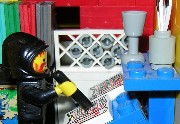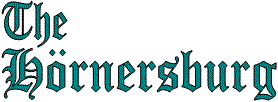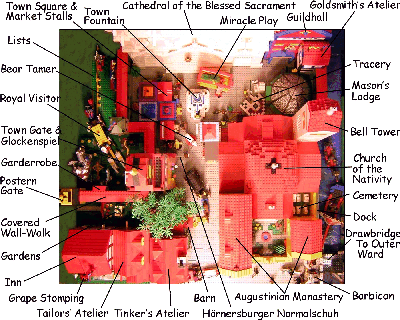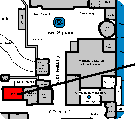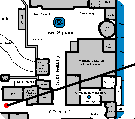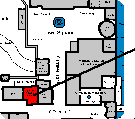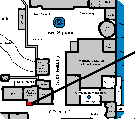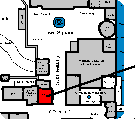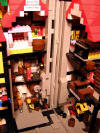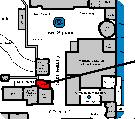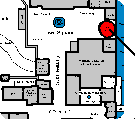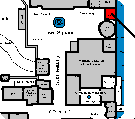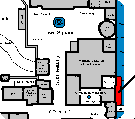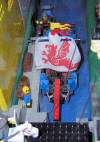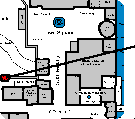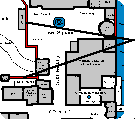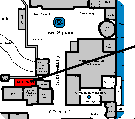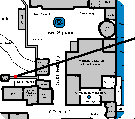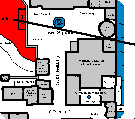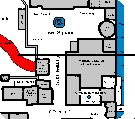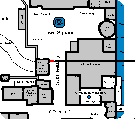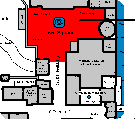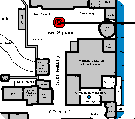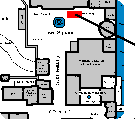things that matter:
quotes to ponder
family things:
fun things:
Medieval Legoģ
Town
- Tour Stop 4 -
Showing left-to-right: Inn of the Jumping Fish,
Tailor's Atelier, Tinker's Atelier, Augustinian Monastery,
and Barbican which leads to the Outer Ward
|
Across the drawbridge from the Hoernersburg Lego Castle is the town of Legoland. This town is filled with all sorts of shops and buildings and lots of exciting things to see and do. On this tour stop, we'll visit several shops and buildings near the town center. |
|
Bird's Eye View of |
|
Inn of the Jumping Fish* Here is the Inn of the Jumping Fish. People visiting the town can spend the night here or get something to eat or drink. The innkeeper is in charge of the inn. He is also its owner. (*Inspired by Crossroads Tavern designed by Daniel Siskind) |
|
The Lego Inn is hinged and can be opened to view the interior. |
|
Shop Sign Above each shop in town is a sign indicating what sort of shop it is. Thatís because most people canít read. The sign over the Inn is a keg and tap. Keep your eyes open for other signs in the town and see if you can guess whatís sold there. |
|
Innkeeper This is the innkeeper. Owning an inn carries a lot of responsibility. He has to make sure itís cleaned, maintained, and serves good food and drink. |
|
Great Blood Sausage Here are a few guests having something to eat. This Inn serves some of the best blood sausage and sauerbraten in town. |
|
Guestrooms Upstairs are plenty of guestrooms. Try to be quiet, it looks like someoneís trying to take a nap. |
|
Chamberpot Hereís a guest using a Chamberpot. These are particularly useful on cold nights if the privy is located outdoors. |
|
Grape Stomping Before grapes can be made into wine, the juice needs to be removed. Here is a girl stomping on some grapes with her bare feet. |
|
Tailor's Atelier Next weíll visit the Tailorís Atelier. This is where the Tailor makes clothing for people that can afford it. Many craftsman are required to turn wool from a sheep into clothing fit to be worn. A Spinner turns wool fibers into yarn. A Weaver turns the yarn into cloth on a loom. A Fuller cleans the cloth. A Dyer colors the cloth. A Tailor turns the cloth into clothing. However, most people make their own clothes, usually by spinning and weaving the cloth themselves. Poor people canít afford to dye their cloth. Poor men usually wear a shirt and linen breeches held up with a piece of string tied around their waist. Sometimes they wear a tunic on top. Women usually wear a linen smock with a loose fitting tunic over that. |
|
Welcoming Cellar Hey, look what I see in this cellar open to the street. A welcoming goblet filled with wine. Oops, just an illusion. |
|
Sweeping Laws Notice this man sweeping the walk. There are certain laws about cleaning your walkways on Saturday. |
|
Tinker's Atelier Here is a good example of a Half-Timber Building. This is a common form of construction in which walls are made of a wooden frame filled with wattle and daub. Between the large timbers, narrow sticks are woven in and out. Then, theyíre covered over with Daub. Daub is made from mud mixed with straw, cow hair and dung. By the looks on your faces, youíre obviously aware that these walls donít smell so good. Wait Ďtill it rains. This building happens to be the Tinkerís Atelier. |
|
Like the Lego Inn, the Tinker's Shop is also hinged and can be opened to view the interior. |
|
Tinker's Workshop The Tinker mends and makes brass kettles, pans, and other metal ware. Here is a young Apprentice helping him out. |
|
Tinker's Wares The Tinker has lots of interesting things for sale. |
|
Tinker's Family's Quarters Like other Ateliers, the Tinker's family lives upstairs. This is his daughter Hildegard. |
|
Tinker's Wife Over here is his wife working hard. Upstairs, you can see that they have a large wooden cask for taking an occasional bath. |
|
Barn Next to the Tinkerís Atelier is his barn. This is where he keeps his cart and horses. If you look carefully, you can see one of his sons hoisting some hay into the top of the barn. In Germany, many of the barns are right in the town. Folks that have crops go outside the town during the day to work their fields. They come back to town in the evening. |
|
Mason's Lodge This is the Masonís Lodge. Itís a temporary workshop where the Master Mason is designing and overseeing the building of the Cathedral. It can take decades to finish a Cathedral. The Master Mason oversees an army of workers: Quarrymen, Rough Masons, Freemasons, Lime-burners, Morter Makers, Basket Boys, and many more. On the ground you can see some Tracery. This is carefully cut stone filled with precious pieces of stained glass. When itís finished, it will be placed into the Cathedral wall. Next to that is a Sculptor chiseling away at a statue for the Cathedral. |
|
Goldsmith's Atelier Here is the Goldsmithís Atelier. The Goldsmith makes gold articles, such as chalices, patens, and crucifixes for the cathedral. Because his shop is well-protected (because of the gold), many people also leave their money here for safekeeping. The Guildhall is where members of a guild meet. All craftsmen belong to a particular craft guild. Before someone can become a Master Craftsman, he must start out as an Apprentice. After gaining experience, he becomes a Journeyman. After many years, when he finally presents a "Masterpiece" of his own work to the guild, he becomes a Master and can open his own shop. |
|
Town Dock Raw materials for the Craftsmen arrive daily on boats. When the boats leave, they take with them finished goods to sell in other towns up and down the river. |
|
Town Gate The town of Legoland is well protected. It is surrounded by a tall wall. Entrance to the town is through the Town Gate. |
|
Town Sentry The Town Gate is closed at night and a Sentry keeps guard. |
|
Glockenspiel This town gate has a Glockenspiel. A Glockenspiel is an animated tower clock that plays music and tells a story with mechanical figures. This one tells the story a saintly hooded girl who beleaguered young King Rudolf around town until he mended his ways. |
|
Postern Gate A secondary entrance into the town is through the Postern Gate. This gate has a scary face from which burning tar can be dropped. It serves to scare troublemakers away. |
|
Covered Wall-Walk On top of the town wall is a covered Wall-Walk. This is a footpath from which sentries can keep watch. |
|
Gardens From on top the Wall-Walk, the gardens of many ateliers are visible. People like to tend their gardens, where they mostly grow vegetables instead of flowers. |
|
Garderobe On the other side of the Wall-Walk is a sight not quite as appealing. Here is a garderobe whose droppings fall straight to the ground. |
|
Lists Outside the town are the Lists. This is area of land where tournaments take place. Spectators in the Pavilion like to watch heavily armoured knights charging at each other on horseback, each trying to knock the other off with his wooden lance. |
|
Knighthood Look! Hereís a squire being dubbed a Knight. Good Knights follow a code of conduct, known as chivalry. This code demands that he should be brave, truthful, Godly, faithful, and fearless. He should especially behave honorably towards women. He is expected to help anybody in need that calls for it. To become a knight, a boy starts his training as a Page at about age seven. At age fourteen he becomes a Squire. On the day before a Squire becomes a knight, he goes to church with his armour. In front of the altar with sword in hand, he kneels in front of the altar for ten hours without food or drink. This is a test of self-discipline. He prays and thinks deeply about the meaning of chivalry all night. At dawn he confesses his sins to a priest. Then, he eats a big breakfast before heís finally dubbed a knight. |
|
Royal Visitor Wow! Look, the Holy Roman Emperor is coming to town. The Holy Roman Emperor rules over lots of other Kings, Princes and Barons throughout Germany and much of Europe. Charlemagne was the precursor to the first Holy Roman Emperor. |
|
Hoernersburger "Normalschuh" After entering the town, we glimpse a rod called the "Hoernersburger Normalschuh". This is a standard length that merchants must use for measuring. It helps keep them from cheating. |
|
Town Square Next, weíll make our way to the Town Square. This is a large public area in front of the Cathedral. In the Town Square there are many Market Stalls from which Merchants are selling their goods. Hats, gloves, musical instruments, fabric, pots and pans, girdles, swords, capes, saddles, apples, roasted chestnuts and Pigs Ears. |
|
Bear Tamer Take a look at the Bear Tamer. He can make the bear stand or sit or wave its paws. He can even put his head into the bearís mouth and live to tell about it. |
|
Town Fountain The Town Fountain is in the middle of the Square. Itís where townspeople fetch their water. A little metal channel pours water into their bucket. |
|
Miracle Play Traveling Actors and Troubadours often come to town and put on Miracle Plays in front of the Cathedral steps. They show stories from the Bible or the lives of the saints. This play is about Saint George and the dragon. Letís watchÖ |
More
►Tour Stop 1: Lego Castle & Great Hall
►Tour Stop 2: Lego Castle Keep
►Tour Stop 3: Lego Castle Outer Ward
►Tour Stop 4: Medieval Lego Town << you are here
►Tour Stop 5: Lego Cathedral & Monastery
▬▬▬▬▬▬▬▬▬▬▬▬▬▬▬▬▬▬
►Tale of the Hoernersburg: How the castle got its name
►Watch the Lego Castle Tour Movie
